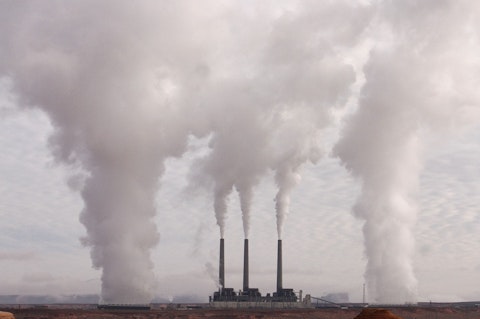In this article, we will be taking a look at the most polluted cities in the world. To skip our detailed analysis, you can go directly to see the 5 most polluted cities in the world.
Pollution is one of the biggest issues facing most of the world right now. In fact, it is the largest environmental cause of premature death and disease, causing more than 11 million deaths which is several times greater than the major diseases such as tuberculosis, malaria and AIDS combined. While pollution has been an issue since industrialization, it has been exacerbated in recent decades because of the use of pesticides, crop residues in agriculture, forest fires, urbanization, desert dust and inadequate waste management. Pollution not only causes disease, it stunts growth, creates disastrous living conditions and results in the destruction of ecosystems as well.
The Covid-19 pandemic was a timely reminder of the link between pollution and human activity, as global lockdowns resulted in economic shutdowns, which in turn significantly decreased pollution as well. Images of cities were widely shared which showed the impact of the reduction of pollution during lockdowns. However, that was just a temporary respite, and once lockdowns were ended, and economic and industrial activities resume, so did the level of pollution.

Pixabay/Public Domain
Air pollution is one of the worst forms of pollution and is the leading environmental risk to health. According to a report by the World Bank, air pollution results in costs of $8.1 trillion in 2019, which is equal to around 6.1% of the world’s GDP. Further, 95% of the total deaths caused by air pollution occur in low and middle-income countries. The reason behind this is that such countries have much laxer regulations which companies exploit. This can attract companies which do not want to operate in more developed countries because of stricter regulations, and also because of a lack of oversight by the governments.
It is important to note that it is mostly companies who are causing this pollution, and despite pressure on individuals to reduce their carbon footprint and reduce pollution, this is just a blame shifting tactic by major companies who earn billions of dollars a year and contribute significantly to pollution globally. In fact, according to the Political Economy Research Institute, which issued its 2021 Greenhouse 100 Polluters Index based on 2019 data, mentioned the biggest polluters in the United States. A lot of energy companies were near the top of the list, including Vistra Energy, Duke Energy Corporation (NYSE:DUK), Berkshire Hathaway Inc. (NYSE:BRK.A), The Southern Company (NYSE:SO) and American Electric Power Company, Inc. (NASDAQ:AEP). In fact, just 10 companies contribute nearly a tenth of all greenhouse gas emissions from all source in the United States in 2019, signifying just how significant the impact of companies is on pollution. To further illustrate this point, according to a Guardian report in 2017, just 100 companies were responsible for 71% of total global emissions. While it may be better for the average person to not use single-use plastic, straws and take the train instead of a plane, that won’t have as much effect as holding companies accountable for the damage they’re doing.
Most companies have realized that investors aren’t just looking for quick returns, but they want to see how the company is working on improving the environment as well, in addition to social work. This is why many companies are actually exaggerating how much they’re doing to reduce their carbon footprint. According to the BBC, many major companies ‘routinely exaggerate or misreport their progress”, which includes giants such as Alphabet Inc. (NASDAQ:GOOG), NIKE, Inc. (NYSE:NKE), Apple Inc. (NASDAQ:AAPL) and Amazon.com, Inc. (NASDAQ:AMZN).
On the other hand, there is now a booming industry working on reducing pollution. Some of the companies focused on cleaning up oceans include The Ocean Cleanup, with whom The Coca-Cola Company (NYSE:KO) has teamed up to clean up a river in Vietnam. Other companies involved in this include Clearwater Mills and AlphaMERs.
To rank the 25 cities with the most pollution, we relied on data provided by the World Air Quality Report 2021 by IQAir. As mentioned earlier, air pollution is the most damaging form of pollution, so it is only fair to use air quality index as a measurement. While China used to have several cities among the most polluted in the world, it has made significant strides with stringent regulations imposed on companies. Unfortunately, India seems to have picked up the slack, with 18 out of 25 cities being from India. So, without further ado, let’s take a look at the most polluted cities in the world, starting with number 25:
25. Meerut, India
Annual average PM2.5 concentration (μg/m³): 80.6
Located in Utter Pradesh, Meerut is home to more than 1.5 million people, and is considered to be one of the biggest producers of sports good and musical instruments in the country.
24. Bulandshahr, India
Annual average PM2.5 concentration (μg/m³): 80.8
The PM2.5 concentration in Bulandshahr is, at this moment, more than six times greater than the WHO annual air quality guideline value. Residents of the city have been advised to keep windows closed to avoid dust and sensitive groups should avoid exercising outdoors.
23. Sahiwal, Pakistan
Annual average PM2.5 concentration (μg/m³): 81.7
After India, Pakistan has the most number of cities among the most polluted cities in the world, and we start off with Sahiwal, located in the province of Punjab. There are close to 400,000 people living in the city.
22. Varanasi, India
Annual average PM2.5 concentration (μg/m³): 82.6
One of the world’s oldest continually inhabited cities, Varanasi has seen really high pollution mainly due to a high population density, and lack of oversight. The city is on the Ganges River and pollution of the Ganges River has raised concern throughout the country and beyond, especially because of the religious significance of the river and people’s dependence on it as a source of water.
21. Muzaffarpur, India
Annual average PM2.5 concentration (μg/m³): 82.9
Located in the state of Bihar, the main sources of pollution in Muzaffarpur include vehicular emissions, road dust, open waste burning, construction activities, industrial emissions and domestic fuel burning.
20. Kanpur, India
Annual average PM2.5 concentration (μg/m³): 83.2
Kanpur is home to the coal industry, and the coal being burned by the industry is a major source of pollution, as is car emissions plying unpaved roads, not to mention pollution caused by tanneries.
19. Kashgar, China
Annual average PM2.5 concentration (μg/m³): 83.2
China also enters the list of the most polluted cities in the world, with Kashgar, and has an urban population of around 920,000 people.
18. Gurugram, India
Annual average PM2.5 concentration (μg/m³): 83.4
Located in Haryana, Gurugram has been battling socio-economic issues, which include high pollution and income inequality.
17. Jind, India
Annual average PM2.5 concentration (μg/m³): 84.1
The oldest city in the Jind district, the city is home to around 170,000 people and the high usage of traditional vehicles is one of the main sources of pollution.
16. Lucknow, India
Annual average PM2.5 concentration (μg/m³): 86
The capital and largest city of Utter Pradesh, Lucknow has a population in excess of 3.5 million people. Due to the high level of pollution caused by vehicles, the city introduced CNG (compress natural gas) as a source of fuel for vehicles to keep air pollution under control.
15. Lahore, Pakistan
Annual average PM2.5 concentration (μg/m³): 86.5
Lahore is the capital of Pakistan’s most populous province of Punjab, and the high levels of pollution in the city are said to reduce the life expectancy of an average person in the city by 6.8 years.
14. Rohtak, India
Annual average PM2.5 concentration (μg/m³): 86.9
Rohtak is located in the province of Haryana in India, and has a population of around 400,000 people.
13. Greater Noida, India
Annual average PM2.5 concentration (μg/m³): 87.5
A planned city, Greater Noida is home to illegal mining, which is one of the reasons behind the city being very polluted.
12. Faridabad, India
Annual average PM2.5 concentration (μg/m³): 88.9
The most populous city of Haryana is also one of the most polluted cities in the world, even though it has improved, having been recorded as the second most polluted city in the world in 2018 by the World Health Organization.
11. Hisar, India
Annual average PM2.5 concentration (μg/m³): 89
Haryana has quite a few entries in this list and Hisar is definitely one of the most polluted cities in the state, with crop burning or stubble burning by farmers being one of the driving factors behind the high levels of pollution found in the city. Further, the city has seen high levels of growth in recent years, which have exacerbated the issue. The city also has vehicles which are quite old, and run on lower quality fuels.
10. Bagpat, India
Annual average PM2.5 concentration (μg/m³): 89.1
With PM2.5 concentration of 89.1, Bagpat just makes the top 10 most polluted cities in the world.
9. Peshawar, Pakistan
Annual average PM2.5 concentration (μg/m³): 89.6
Peshawar is the capital of the Khyber Pakhtunkhwa province, and sees much higher pollution in the colder months because of burning of materials for heat, as well as the cold air trapping pollution. Another reason behind the dangerous levels of pollution is the number of vehicles present in the city, including motorbikes and rickshaws, which use low quality fuel and play a major part in pollution. Add to this the constant parade of heavy duty trucks and vehicles through the city carrying goods and you have a perfect recipe for disaster.
8. Bahawalpur, Pakistan
Annual average PM2.5 concentration (μg/m³): 91
Bahawalpur is Pakistan’s most polluted city, and number 8 among the most polluted cities in the world. Emissions from vehicles and industrial processes are the main causes of pollution, as thousands of smoke-emitting vehicles which aren’t really roadworthy are driven daily on dilapidated roads. Biogas is also used in kitchens, the construction industry and power generation, not to mention garbage burning. While Pakistan has often blamed India for cross border pollution, the country definitely needs to take steps to ensure that pollution is controlled and decreased.
7. Noida, India
Annual average PM2.5 concentration (μg/m³): 91.4
At one point in 2019, Noida was the most polluted city in India, but has improved slightly in the last couple of years.
6. Faisalabad, Pakistan
Annual average PM2.5 concentration (μg/m³): 94.2
Faisalabad’s pollution, like most cities in Pakistan, is caused by low quality vehicles plying the roads, not to mention that it is considered to be the home of textile in Pakistan, and hence, is host to many factories and textile mills, along with thousands of brick kilns, all of which contribute to the pollution in the city.
Click to continue reading and see the 5 Most Polluted Cities in the world.
Suggested articles:
- 20 Companies That Are The Biggest Polluters in the World
- 30 most polluted cities in the US
- 20 Cities With The Best Air Quality in the U.S.
Disclosure: None. 25 most polluted cities in the world is originally published at Insider Monkey.





